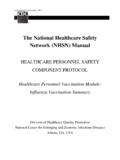Transcription of Evaluation of Background Metal Concentrations in Ohio Soils
1 Evaluation of Background Metal Concentrations in Ohio Soils June 21, 1996 Submitted to:Ohio Environmental Protection Agency1800 WaterMark Drive, Columbus, Ohio 43266-0149 Submitted by:Craig A. Cox, CPG George H. Colvin, CPGCox-Colvin & Associates, Bethel Road, Suite 101 Columbus, Ohio 43220(614) 442-1970 Evaluation of Background Metal Concentrations in Ohio Soils June 21, 1996 Cox-Colvin & Associates, Inc. 1 IntroductionSoils contaminated by metals are common at many industrial sites in Ohio and across the mere presence of metals in Soils , however, does not necessarily indicate contamination becauseall Soils naturally contain at least trace levels of metals ( EPA, 1992a).
2 The presence, nature,and extent of soil contamination by metals is commonly determined through comparisons of samplesfrom "affected" locations to those from "unaffected" locations at or near the site, or to publishedregional Metal Concentrations . These "unaffected" Concentrations are commonly referred to asbackground. Background Concentrations for naturally occurring constituents are used not only todetermine the presence, nature, and extent of contamination but also are used to aid in theestablishment of soil remediation goals. Such Background -related evaluations are often requiredunder the Resource Conservation and Recovery Act (RCRA) and the Comprehensive EnvironmentalResponse, Compensation, and Liability Act (CERCLA).
3 In most cases, a direct statistical comparison to Background data collected at a site is preferable overcomparison to regionally derived Background levels. Site-specific Background data are preferredbecause the concentration of metals in unaffected soil varies from location to location, dependingnot only on the geology of the parent material from which the soil was derived, but also on climaticconditions and local land use patterns. Despite the obvious advantages of direct statisticalcomparison to site specific Background data , a simple comparison or, in some cases, a statisticalcomparison to regionally derived Background data may be appropriate or even preferable in somesituations.
4 For example, the lack of time or funding may prevent collection and analysis of sufficientbackground data . In other cases, it may be impossible to collect representative Background data atan industrial facility due to limited space or the lack of an area unaffected by waste Background Metal Concentrations in Soils are available on a nation-wide level. Commonlycited references on this subject include Shacklette and Boerngen (1984), and Holmgren and others(1993). Whereas Background soil data of this sort may be useful for making general comparisonsfrom one state or region to another, localized databases are preferable for focusing on environmentalobjectives such as determining whether or not a release has occurred or in developing remediationgoals.
5 Logan and Miller published Background levels for cadmium, chromium, copper, lead, nickel,and zinc from farm soil in seven counties in Ohio (Logan and Miller, 1983). While providing areasonable estimate of Background Metal Concentrations for each of the seven counties, the limitedspatial variability of the data prevent adequate characterization of Background for the state as awhole. Utilization of the Logan and Miller data is also limited by the number of metalscharacterized. Clearly, a more comprehensive data set is required to adequately characterize thevariation of Background Metal Concentrations across the state.
6 The primary objective of this study is to provide a state-wide statistical Evaluation of backgroundmetal Concentrations in Ohio Soils , for use by industry, regulatory agencies, consultants and thegeneral public. This study utilizes Background data collected from environmental investigationsEvaluation of Background Metal Concentrations in Ohio Soils June 21, 1996 Cox-Colvin & Associates, Inc. 2across the state, and provides state-wide Background Concentrations for 20 metals. The assembleddata set is from 64 sites in 36 of Ohio s 88 counties. Due to the individual nature of theenvironmental reports used throughout the study, many of the sites do not include analyses for all20 study was conducted in association with the Ohio Environmental Protection Agency (OhioEPA) Division of Hazardous Waste Management.
7 Involvement of the Ohio EPA in the project doesnot imply endorsement of the findings of the study by Ohio EPA nor should this report be construedas Ohio EPA guidance. No source of outside funding was used in the development of this in Background SoilNearly all of today s Soils have been affected to some extent by anthropogenic processes. Farm soil,for instance, may contain heavy metals associated with sewage sludge application (Logan and Miller,1983) and/or the direct application of fertilizers containing metals such as manganese, copper, zinc,boron, and potassium (Ohio Agricultural Guide, 1988). Soils in urban settings often contain elevatedlevels of metals related to fallout associated with the burning of fossil fuels and refuse for thegeneration of heat and power, or from other industrial sources.
8 In addition, elevated concentrationsof lead have been documented along roadways (Holmgren, , 1983).As a result, Soils used to characterize Background within Ohio may have a subtle overprint of theseand other anthropogenic sources. This generalization certainly is true for Background data collectedfrom areas within or surrounding industrial facilities. However, as demonstrated by this study, Background data affected by industrial activities (termed industrially-impacted soil) in many casescan be separated from those Background data that represent soil conditions present throughout muchof the state.
9 Background data SetData used in this Evaluation of Background Metal Concentrations in Ohio Soils were compiled frompublic Ohio EPA files for RCRA closure, RCRA Corrective Action, and CERCLA projects. OhioEPA Division of Hazardous Waste Management, Central Office coordinated the selection of thereports to be included in the study. All of the reports that contained Background metals data wereconsidered for inclusion in the database. In several cases, specific sites were removed from thedatabase at the request of Ohio EPA District Offices based on the location of the backgroundsamples.
10 Background data from 64 environmental projects conducted between 1984 and 1994 wereused in the study. A list of the sites and the associated metals utilized in the study is provided inTable 1. A total of 36 of the 88 counties in Ohio are represented in the study (Figure 1). Evaluation of Background Metal Concentrations in Ohio Soils June 21, 1996 Cox-Colvin & Associates, Inc. 3 data EntryMetal concentration data were entered into a relational database using a database applicationdesigned specifically for this project. Because Metal Concentrations in soil may be dependent on anumber of variables ( , the local setting, the parent geologic material, depth, and land use history),the database file structure was designed so that Evaluation by a number of criteria could be madeeasily.




